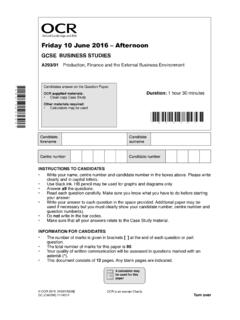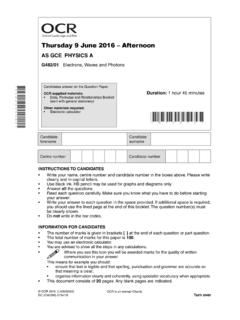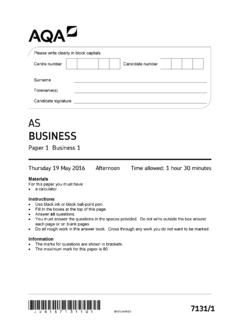Transcription of AS Psychology Question paper Paper 2 June 2016
1 *Jun1671810201* IB/G/Jun16/E2 7181/2 AS Psychology Paper 2 Psychology in Context Monday 23 May 2016 afternoon Time allowed: 1 hour 30 minutes Materials For this Paper you may use: a calculator. Instructions Use black ink or black ball-point pen. Fill in the boxes at the top of this page. Answer all questions. You must answer the questions in the spaces provided. Do not write outside the box around each page or on blank pages. Do all rough work in this book. Cross through any work you do not want to be marked. Information The marks for questions are shown in brackets. The maximum mark for this Paper is 72. You will be assessed on your ability to: use good English organise information clearly use specialist vocabulary where appropriate. Please write clearly in block capitals.
2 Centre number Candidate number Surname Forename(s) Candidate signature 2 *02* IB/G/Jun16/7181/2 Do not write outside the box Section A Approaches in Psychology Answer all questions in this section. For each multiple-choice Question , completely fill in the circle alongside the appropriate answer. If you want to change your answer you must cross out your original answer as shown. If you wish to return to an answer previously crossed out, ring the answer you now wish to select as shown. 0 1 Which two of the following statements about the divisions of the nervous system are correct? Shade two boxes only. In the human nervous A the fight or flight response occurs when the parasympathetic division controls functioning. B the central nervous system consists of the brain and spinal cord.
3 C sensory, relay and motor neurons are all controlled by the somatic nervous system. D sensory neurons carry messages from the central nervous system. E the somatic nervous system controls voluntary movements. [2 marks] CORRECT METHOD WRONG METHODS 3 *03* Turn over IB/G/Jun16/7181/2 Do not write outside the box 0 2 Briefly outline how excitation and inhibition are involved in synaptic transmission. [4 marks] Extra space Turn over for the next Question 4 *04* IB/G/Jun16/7181/2 Do not write outside the box 0 3 Read the following descriptions of behaviour: A Sarah is terrified of lifts because she was trapped in one for 5 hours. She cannot go in a lift now.
4 B Jerry watches as his brother James is given sweets for cleaning their pet hamster s cage. The next day, Jerry s mum finds Jerry cleaning out the hamster cage. How can the behaviours described in A and B above be explained by learning theories? [6 marks] A B 5 *05* Turn over IB/G/Jun16/7181/2 Do not write outside the box 0 4 In a study of tooth decay, researchers checked the dental records of 100 pairs of identical twins. They recorded the number of fillings for each twin and found the following data: Table 1 Twin pairs with the same number of fillings Twin pairs with different number of fillings 48 52 Use your knowledge of genotype and phenotype to explain the data in Table 1.
5 [4 marks] 6 *06* IB/G/Jun16/7181/2 Do not write outside the box 0 5 Outline two features of the cognitive approach. Explain two limitations of the cognitive approach. [8 marks] 7 *07* Turn over IB/G/Jun16/7181/2 Do not write outside the box Extra space 24 8 *08* IB/G/Jun16/7181/2 Do not write outside the box Section B Psychopathology Answer all questions in this section. For each multiple-choice Question , completely fill in the circle alongside the appropriate answer.
6 If you want to change your answer you must cross out your original answer as shown. If you wish to return to an answer previously crossed out, ring the answer you now wish to select as shown. 0 6 Read the four definitions of abnormality below (A-D). A Failure to function adequately B Deviation from social norms C Statistical infrequency D Deviation from ideal mental health In the table below, are descriptions of abnormal behaviour. Choose the definition that best matches each description and complete the table by writing A or B or C or D in the box at the end of the statement. Use any letter only once. [3 marks] Behaviour which is rare and not exhibited by many people Behaviour which does not fit the rules of expected behaviour Behaviour which shows an inability to cope with everyday life CORRECT METHOD WRONG METHODS 9 *09* Turn over IB/G/Jun16/7181/2 Do not write outside the box 0 7 Describe at least one strategy that might be used in cognitive behaviour therapy for depression.
7 [4 marks] Extra space 0 8 Below are four evaluative statements about cognitive behaviour therapy. Which statement is correct? Shade one box only. Cognitive behaviour A can only be used in group situations. B allows the client some control over the therapy. C has many side effects. D does not need a trained therapist. [1 mark] 10 *10* IB/G/Jun16/7181/2 Do not write outside the box 0 9 Saira has a fear of cats. Her fear stops her from going anywhere she thinks she might see a cat. Explain how Saira s phobia could be treated using systematic desensitisation. [4 marks] Extra space 11 *11* Turn over IB/G/Jun16/7181/2 Do not write outside the box 1 0 Two students were discussing their friend David who has recently been diagnosed with obsessive-compulsive disorder (OCD).
8 Melanie says, It wasn t a surprise to me that David has OCD because his mum is always tidying things, putting them in order and checking switches . Emma says, Really, I didn t know that. I always thought that people with OCD have something in their brains that makes them behave in that way . Outline and evaluate neural and genetic explanations for obsessive-compulsive disorder. Refer to the conversation above in your answer. [12 marks] You may use this space to plan your answer. 12 *12* IB/G/Jun16/7181/2 Do not write outside the box 13 *13* Turn over IB/G/Jun16/7181/2 Do not write outside the box 14 *14* IB/G/Jun16/7181/2 Do not write outside the box Extra space 24 15 *15* Turn over IB/G/Jun16/7181/2 Do not write outside the box Section C Research Methods Answer all questions in this section.
9 1 1 A researcher wanted to compare the effectiveness of two therapies for young offenders who had been identified as having anger management issues. Offenders, who were all sentenced to two years in a Young Offenders Institution, were asked to volunteer to take part in an anger management programme. Fifty volunteers were randomly allocated to Group 1 (Therapy A) or Group 2 (Therapy B). Each participant s anger was assessed before and after therapy. For the pre-therapy anger score they completed an Anger Scale questionnaire and their responses were scored. A high score indicated extreme anger and a low score indicated mild anger. For the next eight weeks, participants attended weekly sessions for either Therapy A or Therapy B. For the post-therapy anger score, at the end of the treatment period, participants completed the same Anger Scale questionnaire.
10 The data obtained are shown in Figure 1 below. Figure 1 Median anger scores before and after therapy for Group 1 (Therapy A) and Group 2 (Therapy B) Question 11 continues on the next page 16 *16* IB/G/Jun16/7181/2 Do not write outside the box 1 1 . 1 The researcher used volunteers for this study. Outline one disadvantage of using volunteers to take part in this study. [2 marks] 1 1 . 2 Explain how the researcher could allocate the volunteers randomly to the conditions of the experiment. [3 marks] 17 *17* Turn over IB/G/Jun16/7181/2 Do not write outside the box 1 1 . 3 Write a suitable hypothesis for this study. [3 marks] 1 1.
















